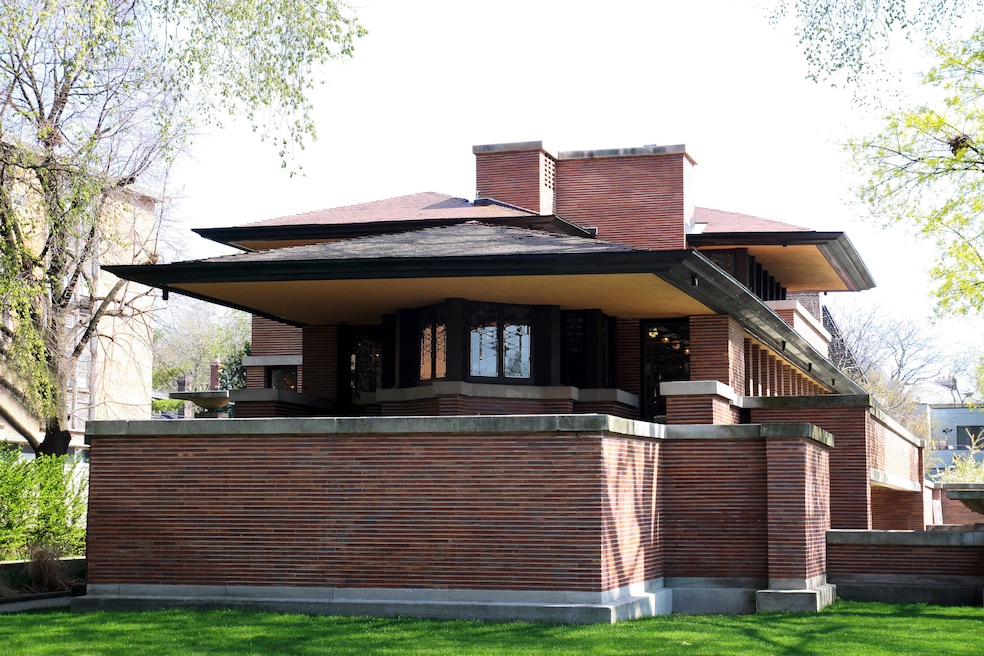Known for its horizontal lines, organic materials and low-slung forms, Prairie-style architecture emerged onto the U.S. scene toward the beginning of the 20th century.
Often heralded as its creator, architect Frank Lloyd Wright popularized and honed the naturalistic style in his work, stitching together approaches from the Arts and Crafts movement with architectural theories from mentor Louis Sullivan, a modernist architect and skyscraper pioneer.
“Wright was on a trajectory where he continuously evolved these ideas,” explained Elizabeth Milnarik, an architectural historian and historical architect with the National Park Service. “And the key ideas — I hate to say it because it’s a terrible cliche — but breaking the box [because] previously houses had all these separate rooms … but his vision was a sort of dynamism.”


It was eventually dubbed the Prairie School, and architects — Wright wasn’t the only one — who embraced the style applied it to private homes and commercial structures alike. The structures had a different ebb and flow from the regimented styles popular in the 19th century, with open interior plans and expansive lines of sight aiming to “unite people and unite space,” Milnarik said.
Materials exemplified a 'love of organic colors'
These buildings also have “this emphasis of the horizontal,” Milnarik said, with their flat planes, low-pitched roofs and rectangular forms often sprawling out in concert with their site and offering plentiful outdoor access. Earth-toned brick, stucco and wood served as favored materials, blending these projects into their burnished surroundings.
The materials exemplified a “love of organic colors,” Milnarik noted, so shades of tawny brown and ochre were paired with bursts of green and the iridescent blue of a Morpho butterfly’s wing. “It’s not a dull palette,” Milnarik said. Wright “is trying to root his buildings in the palette of nature that he sees in the Midwest.”


Wright and many of his peers practiced in and around the Midwest, which still boasts a wealth of 20th century architectural innovation and is rich with examples of Prairie-style buildings. One quintessential example of Prairie-style architecture, the Frederick C. Robie House sits in Chicago’s Hyde Park, where it was completed in 1910 and remains carefully preserved.
“'Robie' is seen as the epitome because it was the last one,” Milnarik said. “Also, it’s great. It’s a great building.
The brick and limestone residence encompasses about 9,000 square feet and features horizontal roofs that extend into dramatically cantilevered eaves. Inside, ample wood and leaded stained-glass windows run throughout the home’s “single room, comprising a living and dining space, divided only by a central chimney,” stated the Frank Lloyd Wright Trust website. “In his design of the 'Robie House,' Wright achieves a dynamic balance between transparency and enclosure, blurring the boundaries between interior space and the world of nature beyond.”
Now 115 years old, the home is a museum and on the UNESCO World Heritage List. The home cost about $58,000 when built, the equivalent of $2.04 million today.
The Usonian period begins
Wright’s Prairie period ended shortly after Robie’s completion, when he left the country after the fallout of an affair with a client’s wife. When he returned to the United States just a few years later, however, he evolved the style, pulling fragments into what became his Usonian period. So, even though the official Prairie School moment lasted less than two decades, the approach has a timelessness that remains “endlessly appealing,” Milnarik said. “People love it.”
“I think the connection to nature is something that really does mean a lot to people,” Milnarik specified. “And I think that is something that resonates and continues to resonate.”
The style was also popular for a simplicity that foreshadowed building and design trends popular through the later 20th century. But it also embodied American architects trying to find a vocabulary of building unique to the country.
“It is an attempt to create a native expression, so I think that is one reason it’s very powerful,” Milnarik said.
